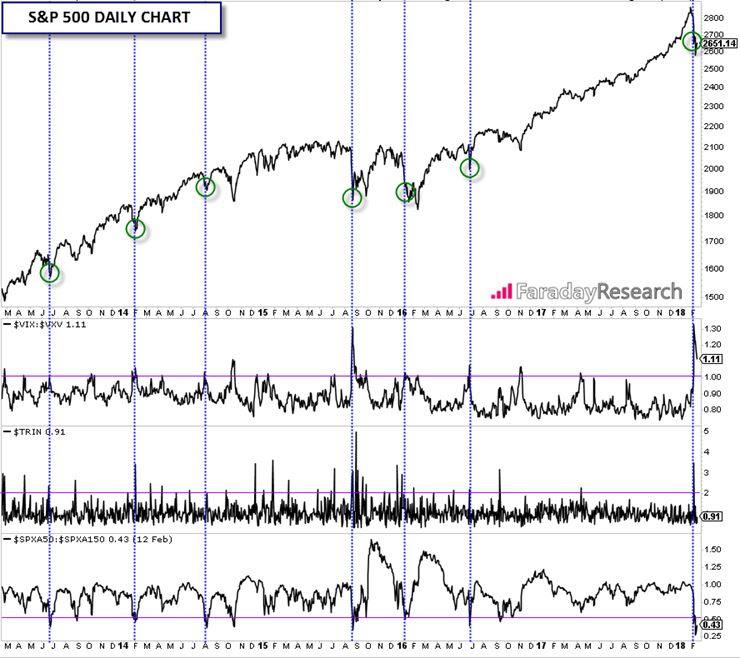The number of superlatives you can use to describe the stock market's recent drop is truly incredible:
- The S&P 500's relative strength indicator (RSI) had previous hit its highest level ever on the weekly chart (near 90).
- It was the first time ever that the Dow fell 10% from all-time highs in just nine days.
- The S&P 500's daily RSI experienced its largest two-week decline on record (-58 points) during the drop.
- et cetera, et cetera, et cetera...
...and despite all that, the S&P 500 is currently trading down by just about 1% on the year after Monday's bounce!
So could we have seen the bottom already?
Despite many quantitative traders' preferences to the contrary, investing will always be more an art than a science. The truth is that there are no iron-clad "laws" of investing and well always being trying to empirically derive "rules of thumb" from ludicrously small, heterogeneous sample sizes. That said, there are certain combinations of indicators that we believe can help identify near-term extremes in market sentiment.
One set of indicators we monitor, shamelessly borrowed from Cam Hui, is called the "Trifecta Model" for spotting near-term bottoms. In essence, it looks for extreme readings across three uncorrelated oversold indicators:
1) The VIX term structure, which measures the implied volatility of front month at-the-money options relative to that of similar options with three months until expiration. In essence, readings about 1.00 on this indicator show excessive short-term fear in the options markets.
2) The TRIN, which compares the number of advancing and declining to stocks to the volume in those stocks. A reading above 2 signals strong selling volume, or excessive fear in the stock market
3) The number of S&P 500 stocks trading above their 50-day MAs relative to the number trading above their 150-day MAs, where a move below 0.5 represents an excessively fast drop in the market relative to the medium-term trend.
The chart below plots the S&P 500 with vertical lines in weeks where all three of the above indicators crossed the above thresholds:
Source: Stockcharts.com, Faraday Research
As you can see, this combination of indicators has done a fairly good job of highlighting short-term oversold extremes over the last five years. Like any model, it's track record isn't perfect though; for instance, it highlighted a possible panic bottom in August 2015, and while the S&P 500 did rally somewhat from those lows over the next two months, it failed to reach a new high and eventually broke back below those lows again in early 2016 (triggering another slightly-premature signal in the process).
That said, last week's signal easily eclipsed all three indicator thresholds, quantifying the amount of panic in the market as the highest in the last five years (with the possible exception of the US debt downgrade in 2015). Over the course of the big nearly-decade long uptrend, similar signals have proven to be near-term buying opportunities more often than not.
This research is for informational purposes and should not be construed as personal advice. Trading any financial market involves risk. Trading on leverage involves risk of losses greater than deposits.
Recommended Content
Editors’ Picks
EUR/USD holds above 1.0700 ahead of key US data

EUR/USD trades in a tight range above 1.0700 in the early European session on Friday. The US Dollar struggles to gather strength ahead of key PCE Price Index data, the Fed's preferred gauge of inflation, and helps the pair hold its ground.
USD/JPY stays above 156.00 after BoJ Governor Ueda's comments

USD/JPY holds above 156.00 after surging above this level with the initial reaction to the Bank of Japan's decision to leave the policy settings unchanged. BoJ Governor said weak Yen was not impacting prices but added that they will watch FX developments closely.
Gold price oscillates in a range as the focus remains glued to the US PCE Price Index

Gold price struggles to attract any meaningful buyers amid the emergence of fresh USD buying. Bets that the Fed will keep rates higher for longer amid sticky inflation help revive the USD demand.
Sei Price Prediction: SEI is in the zone of interest after a 10% leap

Sei price has been in recovery mode for almost ten days now, following a fall of almost 65% beginning in mid-March. While the SEI bulls continue to show strength, the uptrend could prove premature as massive bearish sentiment hovers above the altcoin’s price.
US core PCE inflation set to signal firm price pressures as markets delay Federal Reserve rate cut bets

The core PCE Price Index, which excludes volatile food and energy prices, is seen as the more influential measure of inflation in terms of Fed positioning. The index is forecast to rise 0.3% on a monthly basis in March, matching February’s increase.
